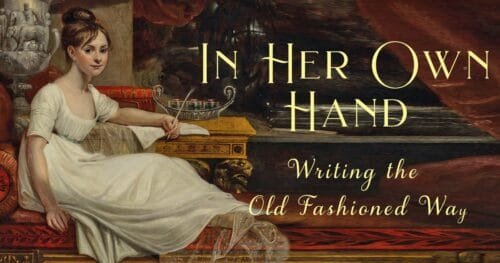
Today, when pennmanship is rapidly becoming a thing of the past, and we type notes into our phones rather than write them by hand, we give little thought to handwriting, much less the different ways in which letters might be formed. That was not the case during the days of writing with quill and ink.
The Polite Lady advised her daughter,
Let me , therefore , advise you , my dear Sophy, to be remarkably careful and diligent in learning the art of writing. Follow the directions of your master, who, I persume , will lay before you the most perfect copies and examples . Of all the various hands, a round hand is, in my opinion, the most proper; for when you are a mistress of that, you may, with great ease, learn either a neat running, or Italian hand; but if you begin with the latter, you never can arrive at any degree of perfection in the former.
When you write never be in a hurry, but proceed with the greatest care and deliberation: always write as well as you can, and then your hand will be still improving; for if you do not, instead of improving, it will every day, become worse.
Polite Lady pg. 8-9
During the High Middle Ages, the book hand used by scribes was the dominate script used–think the gorgeous illuminated manuscripts. Laborious and often difficult to read, few could write or read it, limiting its usefulness. A new style of writing, Secretary Hand developed for use in business and correspondence. From this style, numerous modern script styles developed, including the Round Hand, Runing Hand and Italian hand specifically noted by the Polite Lady.
English Round Hand (also called Copperplate) was the primary style of handwriting from the mid 1700s to 1800s. More legible to the modern reader that Secretary Hand, the Round Hand family of scripts is less ornate, with open flowing ovals, and sloping slanted letters. Less ornate did not mean plain or simple though, ascenders and descenders had loops and flourishes might be used, especially at the beginning and end of lines. Highly readable, but time consuming to write, Jane Austen and the Declaration of Independence used this style of hand.
A more refined version of Round Hand called Italian Hand was used by fine ladies in their correspondence. Developed in the late 16th century, Italian Hand is narrower and more slanted than Round Hand, with less contrast between thick and thin strokes. This style was said to exhibit feminine qualities like grace, lightness of hand, and subtlety, thus rendering its almost exclusively use by women, while men favored the sturdier, bolder Round Hand.
Running Hand provided a more dynamic, less rigid style than Round Hand, with many variants for the letter forms, allowing the user to select the more efficacious form to use as they wrote. The flexibility and variability is probably why the Polite Lady suggests learning it first would be to a lady’s detriment. Running Hand was often used by clerks and in business correspondence. The flowing style makes it the most cursive like of the Round Hand family.
Compare these different styles:
Secretary Hand
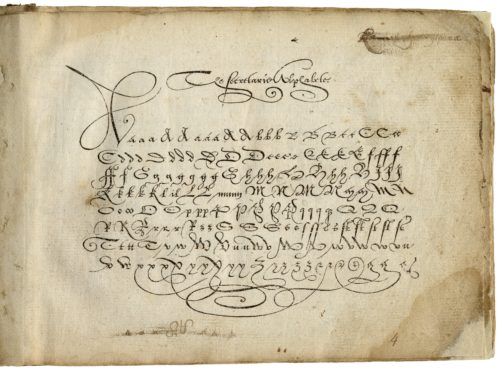
Square Hands (Roman)
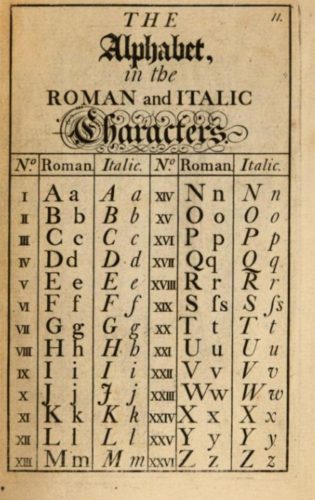
Round Hand/Italian Hand
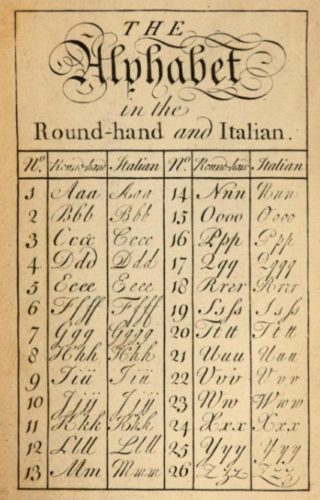
Running hand
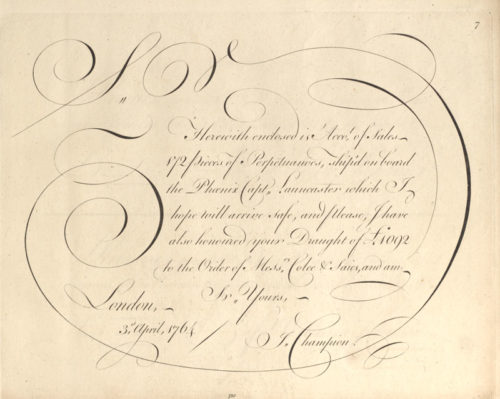
There seemed to be two basic approaches to learning the art of pennmanship. Both relied heavily on the role of practice. John Jenkins’ 1813 Art of Writing breaks letters down into individual strokes, which the student is to perfect by practice, then move on to making letters. The Young Clerk’s Assistant demonstrated the letter forms and instructed the student then to practice them over and over until perfect. Study might be completed under the instruction of a master, or indivudually with the use of a copy book or other instrucitonal tome. In either case, it mean pages and pages and pages of penmanship practice!
It is easy to understand why writing was considered hard work! Tell me what you think.
Find more on the art of writing here.
References
Champion, J., Penmanship Exemplified, 1758
Dehlet, Tamie. Genealogy: Handwriting in the 1700s-1800s Copperplate or English Round Hand. Tribune-Star. May 12, 2013. Accessed Nover 15, 2022. https://www.tribstar.com/news/lifestyles/genalogy-handwriting-in-1700s-1800s-copperplate-or-english-round-hand/article_12f4484a-2739-5d9b-af3c-3beda7a1cf86.html
The Family Of English Round Hands. Penna Volans. Accessed 1/23/2020 https://pennavolans.com/the-family-of-english-round-hands/
HURFORD, ROBERT. Handwriting in the Time of Jane Austen. PERSUASIONS ON-LINE V.30, NO.1 (Winter 2009). Accessed 11/28/22. https://jasna.org/persuasions/on-line/vol30no1/hurford.html
Jenkins. John. Art of Writing.1813
The Polite Lady. 4th ed. Thomas Carnan: London. 1786.
Rodgers, Dave. Introduction to 19th Century Penmanship &How to Do It. Frontier American Illustrated News. December 25, 2020. Accessed Nov 15, 2022. https://www.frontieramericanillustratednews.com/post/introduction-to-19th-century-penmanship-how-to-do-it
The Young Clerk’s Assistant. Lowndes: London 1787
Writing a Running Hand. Her Reputation for Accomplishment. June, 2, 2011. Accessed 11/14/2022 https://herreputationforaccomplishment.wordpress.com/2015/06/02/writing-a-running-hand/

6 comments
Skip to comment form
Thanks, that was very interesting! I dabbled with calligraphy once upon a time and I think that improved my overall penmanship in everyday writing, but even so I wish that I could write with a more elegant hand. (Yes, I am in my 40’s and still like to write hand written letters) It is sad that penmanship is not really taught anymore.
I still use a notebook to take notes for work and then transpose them to online Notes/documents and I use a fountain pen. Growing up in Britain/Caribbean, I was taught to penmanship as I went to school in England, I wrote with a fountain pen. If you made a mistake, you were to put a line thru the error and continue on. I love writing letters, but do not do that as much . I use to write my grandmother letters as she wrote them, she had great penmanship, I would say she wrote Italian or Running Hand. My dad used a fountain pen as well, he was educated in Britain in the 1960s. His hand was very flowy! LOL. I recently returned to using the fountain pen, just after I read the P&P anniversary book with the letters written in them. LOL! Covid also allowed me to write notes to some of my family members, and it was fun. I agree with Jennifer, that penmanship should be taught in school. Thanks for the blog.
When I was in grammar school (Phila., PA) ‘40-50’s, we learned and practiced a cursive style called the Palmer Method always on Friday afternoons. I still write in that style today. In fact, if I’m just doodling I often go through those exercises. I think the students in the parochial school system in this area are still taught it. A lot of others they meet cannot read their written work. A real loss in my opinion. Very interesting article.
When I was in grammar school (Phila., PA) ‘40-50’s, we learned and practiced a cursive style called the Palmer Method always on Friday afternoons. I still write in that style today. In fact, if I’m just doodling I often go through those exercises. I think the students in the parochial school system in this area are still taught it. A lot of others they meet cannot read their written work. A real loss in my opinion. I remember well those desks with the ink well sunk in the top right hand corner. I did have in the higher grades, 6th-8th, a medium blue Parker fountain pen: A very proud possession that I used for years. Palmer Method was an italic slanted round Italian style hand, I would say, in the running method.
I have been learning Copperplate Calligraphy (English Roundhand) over the past two years. I started with Modern Calligraphy taught online by Becca Courtice @TheHappyEverCrafter. Becca teaches a free class in learning the basic strokes that make up both modern and pointed pen calligraphy, and learning Copperplate is a fairly simple jump from the basics. I purchased Becca’s six months of online calligraphy courses via Teachable, and it was well worth the $95 I spent, especially since I can revisit any of the videos whenever I like and can also redownload the practice sheets as needed.
Learning Copperplate has also transformed my everyday handwriting. I use handwriting a great deal as I really don’t remember much of anything unless it passes through my fingers via a pen. I have become a collector of inexpensive fountain pens via Goulet Pens, a family-founded small business with an extensive YouTube archive of how-tos, reviews, fountain pen maintenance and care, etc. Several of my favorite fountain pens were less than $10 each, and I have also invested in a rainbow of bottled inks. For Christmas this year I did receive my first brass pen ($80!) which is a dear little pocket pen, 3 1/2 inches when capped and 5 inches when posted. It’s quite well-named: the Lilliput which is made by Kaweco, a German fountain pen maker.
When writing Copperplate, I use a guide set at a 55-degree angle underneath heavy copy paper atop a small light table (11x 14 inches; $15 on Amazon) to attain the proper line size and angle for the writing I am doing, I often copy literary quotations to practice my letter formation, using an oblique dip pen with a Zebra “G” steel nib and walnut ink — quite Austenesque! It truly is soooo enjoyable and satisfying to slow down and write in the same handwriting style as dear Jane!
Here are some samples of my writing, pinned at the top of my Facebook page: https://www.facebook.com/susanne.barrett/
Happy writing!!
Warmly,
Susanne 🙂
Fascinating, Maria Grace! Thank you so much for sharing such great primary sources, as well as such detailed information generally about penmanship. Yes, it does look like hard work, and it makes me think about the ways in which formulating sentences — not just script — must have been different. If one was taking time to write each letter beautifully and legibly, presumably one was also thinking carefully about each word, each meaning, each aspect of syntax. I wonder to what extent authors had difficulty writing out all they were thinking — or if the slower pace of writing versus typing meant that much of the revision process we undertake now happened in the head versus on paper? Thanks for this thought-provoking post!